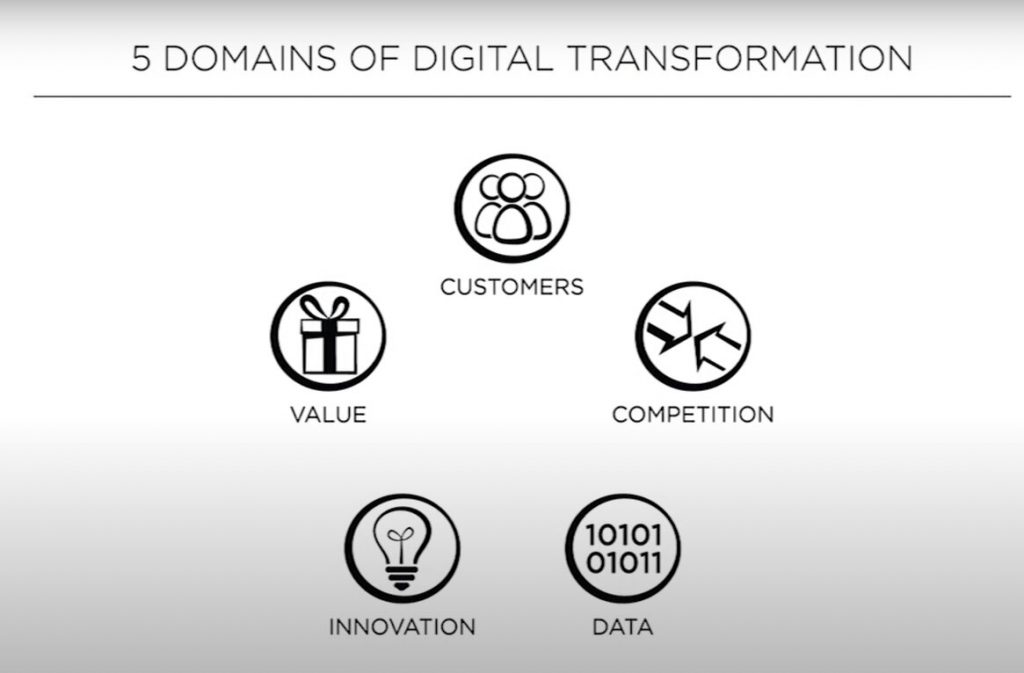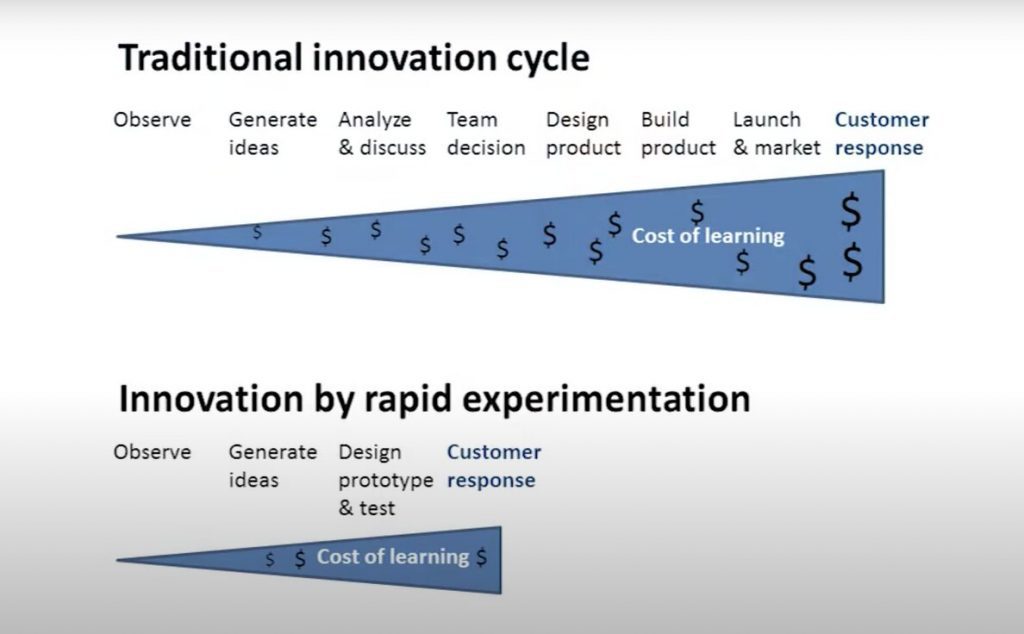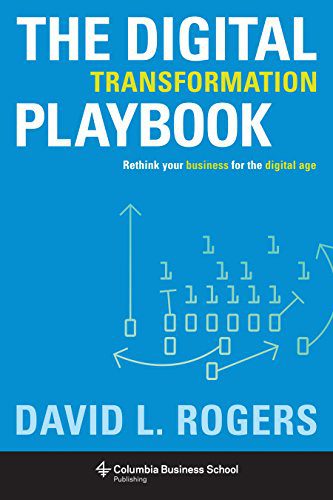Digital transformation is not about technology—it is about strategy and new ways of thinking. Transforming for the digital age requires your business to upgrade its strategic mindset much more than its IT infrastructure.
Print | Kindle(eBook) | Audiobook
It is not a matter of if; it is a matter of when; you either disrupt or be disrupted. David L. Rogers, Faculty Member at the Columbia Business School, argues in “The Digital Transformation Playbook” that Digital Transformation is not about updating your technology but about upgrading your strategic thinking. Digital is disrupting old business models. It is also creating new ones; the book’s main premise is that to succeed amidst the digital revolution requires constant re-invention, leadership, thinking strategically, and thinking in a new way.
Digital transformation is fundamentally not about technology but about strategy. Although it may require upgrading your IT architecture, the more important upgrade is to your strategic thinking.
He sights various examples of organizations that have been able to think more strategically by implementing top notch digital strategy to stay relevant in the digital age. For example, Encyclopædia Britannica vs Microsoft Encarta, Apple vs Nokia, Blockbuster vs Netflix, Traditional Bookstores vs Amazon.
Here are my favourite take aways from reading, The Digital Transformation Playbook by David L. Rogers:
Digital transformation is not about technology—it is about strategy and new ways of thinking. Transforming for the digital age requires your business to upgrade its strategic mindset much more than its IT infrastructure.
Digital transformation requires a holistic view of business strategy.
The rules of business have changed. In every industry, the spread of new digital technologies and the rise of new disruptive threats are transforming business models and processes. The digital revolution has turned the old business playbook upside down.
Businesses founded before the rise of the Internet face a stark challenge: Many of the fundamental rules and assumptions that governed and grew their businesses in the pre-digital era no longer hold. The good news is that change is possible.
Pre-digital businesses are not dinosaurs doomed to extinction. Their disruption is not inevitable. Businesses can transform themselves to thrive in the digital age.
The digital revolution is still just getting started. With an ever-unfolding cascade of new technologies and all the potential they provide, it is impossible to predict how the digital future will impact your business or any industry. But if you are savvy, your business can choose to use each new wave of change as an opportunity to create new value for your customers.
The organizations that flourish in the digital age will combine the right strategic mindset with the right leadership skill set. They will understand the new strategic fundamentals of the digital age and use them to craft new products, services, brands, and business models. Whatever their size, they will maintain the organizational agility to seize new opportunities, and they will balance the art of incubating and learning like a start-up with the art of scaling and integrating like an enterprise.
These organizations will be guided, as their strategies and business models change, by a focus on continuous value creation.
The five domains of business: strategy: customers, competition, data, innovation, and value.

Customers – From passive targets…to dynamic networks
Digital technologies change how we connect and create value with our customers. We may have grown up in a world in which companies broadcast messages and shipped products to customers. But today the relationship is much more two-way: customers’ communications and reviews make them a bigger influencer than advertisements or celebrities, and customers’ dynamic participation has become a critical driver of business success.

Competition – From products…to platforms
Digital technologies transform how we need to think about competition. More and more, we are competing not just with rival companies from within our industry but also with companies from outside our industry that are stealing customers away with their new digital offerings. We may find ourselves competing fiercely with a long-standing rival in one area while leveraging that company’s capabilities by cooperating in another sector of our business. Increasingly, our competitive assets may no longer reside in our own organization; rather, they may be in a network of partners that we bring together in looser business relationships.
A platform is a business that creates value by facilitating direct interactions between two or more distinct types of customers.
Asymmetric Competition
Today, we are moving to a world of fluid industry boundaries, one where our biggest challengers may be asymmetric competitors—companies from outside our industry that look nothing like us but that offer competing value to our customers.
Data – From silos….to strategic asset
Digital technologies have changed our world perhaps most significantly in how we think about data. In traditional businesses, data was expensive to obtain, difficult to store, and utilized in organizational silos. Today, data is being generated at an unprecedented rate—not just by companies but by everyone. Moreover, cloud-based systems for storing data are increasingly cheap, readily available, and easy to use. The biggest challenge today is turning the enormous amount of data we have into valuable information.
To create good data strategy, you must begin with an understanding of the four templates of data value creation, the new sources and analytic capabilities of big data, the role of causality in data-driven decision making, and the risks around data security and privacy.
Innovation – From top-down planning…to experimentation
Digital technologies are also transforming the ways that businesses innovate. Traditionally, innovation was expensive, high stakes, and insular. Testing new ideas was difficult and costly, so businesses relied on their managers to guess what to build into a product before launching it in the market. Today, digital technologies enable continuous testing and experimentation, processes that were inconceivable in the past. Prototypes can be built for pennies and ideas tested quickly with user communities. Constant learning and the rapid iteration of products, before and after their launch date, are becoming the norm.
This new approach to innovation is focused on careful experiments and on minimum viable prototypes that maximize learning while minimizing cost.

Value – From defending…to adapting
The final domain of digital transformation is the value a business delivers to its customers—its value proposition. Traditionally, a firm’s value proposition was seen as fairly constant. Products may be updated, marketing campaigns refreshed, or operations improved, but the basic value a business offered to its customers was assumed to be constant and defined by its industry (e.g., car companies offer transportation, safety, comfort, and status, in varying degrees).
In the digital age, relying on an unchanging value proposition is inviting challenge and eventual disruption by new competitors. Although industries will vary as to the exact timing and nature of their transformation by new technologies, those who assume it will be a little farther down the road are most likely to be run over. The only sure response to a shifting business environment is to take a path of constant evolution, looking to every technology as a way to extend and improve our value proposition to our customers. Rather than waiting to adapt when change becomes a matter of life or death, businesses need to focus on seizing emerging opportunities, divesting from declining sources of advantage, and adapting early to stay ahead of the curve of change.
Build Platforms, Not Just Products
To master competition in the digital age, businesses must learn to cope with asymmetric challengers who are reshuffling the roles of competition and cooperation in every industry. They must also understand the increasing importance of strategies to build platforms, not just products.
digital transformation is not just about having the right strategy; it’s also about making that strategy happen.
Harness Customer Networks Customers
Customers in the digital age are not passive consumers but nodes within dynamic networks—interacting and shaping brands, markets, and each other. Businesses need to recognize this new reality and treat customers accordingly. They need to understand how customer networks are redefining the marketing funnel, reshaping customers’ path to purchase, and opening up new ways to co-create value with customers.
Co-Creation
A brand is no longer something that a business alone creates, defines, and projects outward; it is something that customers shape, too, and the business needs their help to fully create it. Many customers want to do more than just buy products and brands; they want to co-create them.
Five Customer Network Behaviors
Access: They seek to access digital data, content, and interactions as quickly, easily, and flexibly as possible. Any offering that enhances this access is incredibly compelling.
Engage: They seek to engage with digital content that is sensory, interactive, and relevant to their needs.
Customize: They seek to customize their experiences by choosing and modifying a wide assortment of information, products, and services.
Connect: They seek to connect with one another by sharing their experiences, ideas, and opinions through text, images, and social links.
Collaborate: As social animals, they are naturally drawn to work together. Accordingly, they seek to collaborate on projects and goals through open platforms.
Disintermediation and Intermediation
Disintermediation—the removal of an intermediary or middleman from a series of business transactions. The Internet is widely known to have been a powerful force for disintermediation, as it has made it much easier for goods and services of all kinds to reach any audience that wants them.
As an incumbent, you have six possible responses when faced with a disruptive challenger:
THREE STRATEGIES TO BECOME THE DISRUPTER
• Acquire the disrupter
• Launch an independent disrupter
• Split the disrupter’s business model
THREE STRATEGIES TO MITIGATE LOSSES FROM THE DISRUPTER
• Refocus on your defensible customers
• Diversify your portfolio
• Plan for a fast exit
Reimagining your business requires challenging some of its underlying core assumptions. It requires recognizing blind spots you may not realize you have. It requires thinking differently about every aspect of your strategy—customers, competition, data, innovation, and value. This kind of rethinking is difficult—but certainly possible. Just as factories built before the era of electrification were able to revamp their entire way of working and manufacturing, businesses today that were born before the Internet are quite capable of transforming for the digital age.
To develop true organizational agility, your business needs to focus on three areas:
• Allocating resources: How will you decide what to invest in? Are you able to disengage from initiatives and lines of business that lack future potential? Can you apply resources from older business lines to support new ventures?
• Changing what you measure: What outcomes are being measured by senior decision makers? Do they simply relate to existing business practices, or can they support new directions? What should you be measuring at different stages of a transition to a new business model?
• Aligning incentives: What kind of behavior is enabled, supported, and rewarded in your organization? What are managers held accountable for? How are they assigned to new positions? Do compensation and recognition support or hinder the necessary changes in your strategy?
All the Best in your quest to get Better. Don’t Settle: Live with Passion.



1 Comment
Pingback: 100 Books Reading Challenge 2021 – Lanre Dahunsi